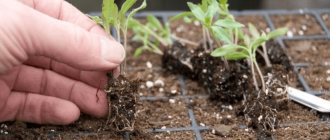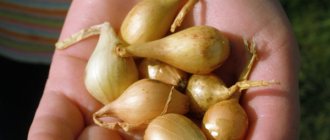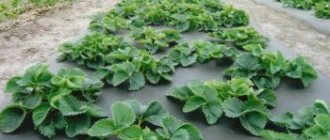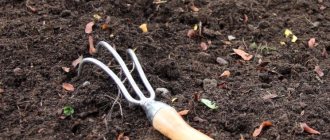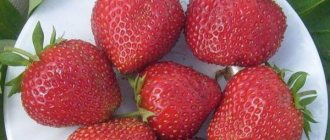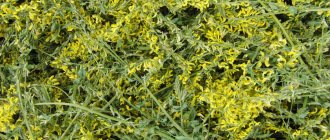Advantages and disadvantages of planting strawberries in the fall
After a stormy garden summer, there is a lull, so there is more free time. It is during this period that you can calmly and measuredly plant or transplant strawberries. The latter is done in order to increase the crop yield for the next season.
There are a number of advantages to autumn planting:
- It will be possible to pick berries next summer. If you plant strawberries in the spring, you will have to wait a year for the harvest.
- The root system has time to adapt and take root in the garden bed.
- After collecting the rest of the plants, there is a lot of space left; you can choose the most favorable part of the site for the upcoming planting.
- In autumn, the weather is as favorable as possible - solar activity is no longer so high, it is cool and humid outside.
- At the end of the season, the sale of various seedlings begins, so you can purchase the rarest varieties. In the spring, there is a high probability of running into low-quality strawberries from long-standing seasons.
- The price of seedlings is lower than in spring.
- The weather is most favorable for transporting strawberries that have been ordered from other regions.
Of course, there is also a risk from planting berries in the fall. The weather in most regions of the country is unpredictable. Sub-zero temperatures may arrive too early, when the roots are not yet well established in the garden bed. It is important to ensure that the first frosts are predicted to occur no earlier than a month after the strawberries are planted in the soil.
Strawberry growing methods
For open ground, the classic planting method is most often used. Since other methods involve the use of special containers or landscape changes, they are used for growing strawberries in greenhouses, on verandas or terraces. Ampelous strawberries are also used as an element of garden design.
Classic ways to plant strawberries
The most common, classic methods of planting strawberries in open ground.
Classic strawberry planting schemes
- One-liner. With this method, a distance of about 60 cm is maintained between rows, and about 15 cm between plants in a row. This planting is recommended for autumn-spring planting.
- Two-line. This method is used in summer: the row spacing is 30 cm, between plants is about 20 cm. The number of plants will be greater than with the one-line method, and accordingly the harvest will be better.
Free distance between rows and plants is an additional preventative measure against the spread of diseases.
Non-standard planting methods
Traditional planting methods are not suitable for small summer cottages. They came up with other ways especially for them.
Vertical planting of strawberries on a construction grid
- Vertical. Planting strawberries in pipes, pots, on construction mesh or old tires. All available material is arranged strictly vertically to save space;
Planting strawberries in plastic bags
- In bags. Plastic bags with soil and strawberry seedlings are laid horizontally or hung vertically. Holes are made for plants to grow;
Planting strawberries under agrospan
- Planting under agrofibre or creating film tunnels. It doesn’t save space, but it allows you to get a harvest faster than with traditional methods;
Growing strawberries hydroponically
- Hydroponics. Strawberry bushes grow on a substrate of mineral wool, peat mixture and coconut fiber. Used in greenhouses on an industrial scale.
Time to plant strawberries in autumn
There is no exact date for autumn planting; it varies depending on the region and weather forecast.
In what month should you plant strawberries in the fall?
Conventionally, planting dates can be divided into three groups:
- early - until the second half of September;
- average - until the second half of October;
- late - must be completed 30 days before the first frost, individual for each region.
Most often, gardeners prefer early and medium planting; it is quite difficult to guess with late planting. If you calculate the timing incorrectly, you can lose the entire harvest and the plant will die.
Experienced gardeners are able to accurately determine the right moment for planting strawberries, focusing on the growing season cycle. Most varieties begin to grow mustache in June, in July they continue to take root in the soil, and already in late summer and early autumn the first buds form.
Weather
The most suitable conditions for planting and replanting strawberries are:
- weather with minimal solar activity;
- air temperature not lower than +10 °C;
- afternoon part of the day.
In autumn there are often hot days; it is better not to plant strawberries at this time.
By region
When planting strawberries in the fall, it is important to focus on the weather conditions characteristic of different regions. The table below shows the optimal time frame for carrying out the work.
| Regions | Deadlines |
| Moscow and Moscow region | from August to September |
| Leningrad region | from mid-August to early September |
| Central Russia | from late August to mid-September |
| Siberia | no later than the end of August |
| Ural | from late July to mid-August |
| Southern regions (Rostov region, Krasnodar region) | From late September to October |
According to the Lunar calendar for 2021
Planting in the fall according to the Lunar calendar will allow strawberries to take root better and produce a good harvest next year.
| Month | Favorable days | Prohibited days |
| August | 1-2, 5-7, 11-12, 15-16, 22-25, 28-29 | 3, 19 |
| September | 3, 6-8, 11-13, 20-25, 29-30 | 2,17 |
| October | 1, 2, 3, 4, 5, 10, 11, 29 | 2, 15,16, 31 |
Choosing a landing site
Competent gardeners lay out new beds for berries every 4-5 years, because there are no nutrients left in the soil, and the bushes are depleted. The plant loves places filled with sun, without stagnant water.
Groundwater must approach the surface to a depth of at least a meter. It is best to grow on the south or east side so that nothing shades the strawberries. From the north, the plantings must be covered with a fence or a series of plantings.
Since strawberries come from the forest (a relative of wild strawberries), the soil should be slightly acidified. Black soil and soil brought from the forest are best suited.
For acid, you can apply special fertilizers, for example, for conifers or rhododendrons and hydrangeas, but in smaller quantities.
Planting strawberries in autumn in open ground
Strawberries are a frequent visitor to garden beds; they do not require much effort when growing and are ready to bear fruit even under not the most favorable conditions. But if you follow all the rules of agricultural technology, you will be pleased with a rich harvest.
Selection of seedlings
You should buy strawberries only from trusted producers, giving preference to nurseries. Private owners' plants may be weak or even completely infected.
It is best to choose seedlings from mother bushes. It is initially immune to diseases and has high productivity. Good seedlings can be recognized by a number of signs:
- The horns are dense, healthy, their thickness should be at least 7 mm.
- The roots are living, branched, up to 8 cm long.
- The leaf blade is dense, shiny, even, bright green in color.
- The number of full leaves is no more than 5.
- The seedlings appear healthy, without damage or signs of infection.
11 Strawberry Varieties Suitable for Fall Planting
Among strawberries, there are several varieties that take root best in the fall and produce an excellent harvest in the spring. These include both remontant (fruit several times per season) and non-remontant (berries are formed once per summer) varieties. We have described them in the table below.
| Name | Varietal characteristics | Repairability |
| Kimberly | The berries ripen early. The bush itself is not too tall and quite small, the leaves are colored light green. Inflorescences are formed at the level of the leaves or slightly below. The berries grow relatively large, 40-50 g, cone-shaped, bright red in color. The variety is resistant to powdery mildew, needs intensive, but not too much watering; for better fruiting, it is recommended to periodically feed the bush. | No |
| Florence | A frequently found variety in garden plots. The bush grows quite large and spreading, shaped like a large green ball. In the first years of growth, a lot of whiskers and horns are formed, but the older he gets, the worse his ability to form whiskers manifests itself. The leaf has a slightly corrugated texture and its color is rich green. The berries are quite large, their weight can reach 60 g. As they ripen, the color changes from red to dark burgundy. The variety is highly resistant to fungi, but often falls victim to various types of spotting. | No |
| Victoria | Perennial large-fruited variety. The bush is strong, blooms with white flowers, which are located several on a peduncle. The leaves are dark green, trifoliate. The berries are deep red, up to 80 grams in size. The pulp is sweet, aromatic, juicy. The variety does not require special care, the most important thing is to water it on time. | Yes |
| Kent | The bush has a vertically oriented shape, the stems are tall, the leaves are attached to them using long cuttings. Thanks to its powerful root system, the plant is highly resistant to temperature changes and frost. The berries ripen early and are shaped like a heart or a cone. The taste is excellent - the fruits are juicy and sweet. Their color is dark red and their weight is 40 g. Strawberries resist gray rot and powdery mildew well. It grows best in chernozem or forest soil; it bears fruit more slowly in marshy, calcareous soils with high acidity. | No |
| Honey | The bush grows spreading and tall, the root system is powerful, which ensures excellent survival rate and accelerates adaptation after planting. A lot of flower stalks are formed, they allow you to reap a rich harvest. The leaf is dark green and the stems are covered with small fluffy hairs. The berries are conical in shape, red in color, and have shiny skin. They ripen early. With proper care, the weight of the fruit can reach 30 g. | No |
| Crown | The ripening period is average. The bushes are small and very compact. In the first season after planting, their height barely reaches 20 cm. The leaves are quite large, the color is dark green, there is a silvery tint, and the shape is slightly concave. The first berries are very prominent, look like a scallop in appearance, weigh up to 30 g. Then the fruits become smaller, the shape is rounded, the surface is leveled. This variety tolerates winter well, feels comfortable in conditions of moisture deficiency and is resistant to brown leaf spot and powdery mildew. Most often it is subject to diseases of gray fruit rot and white spot. | No |
| Ali Baba | The bushes are small, their height is approximately 15 cm, and grow very compactly. Already in the spring, many inflorescences are formed and the harvest pleases with its volumes. The berries are much smaller than classic strawberry fruits, their weight reaches 5 grams, their shape is cone-shaped, and their color is bright red. On fertile lands, the fruits grow slightly larger in size and reach a weight of 6 g. The taste is sweet and sour, even despite the sugar level being above average. The variety is resistant to many diseases and tolerates frost and drought well. | Yes |
| Forest fairy tale | The variety begins flowering at the end of May and continues until the beginning of October. The bush grows small and compact. The berries are small, weighing up to 5 g. | Yes |
| Gum | The variety was bred by Ukrainian breeders and is a favorite of many gardeners due to its excellent yield. The berries ripen very early, are large in size and wide-conical in shape, and dark red in color. The bush is medium in size, the leaves are large, dark green. The bush forms a large number of mustaches. Strawberries tolerate winter frosts well and are resistant to many types of fungus. The main disease to which the variety is susceptible is the strawberry mite. | Yes |
| Rusanovka | The berries ripen early, the bulk weighs 10-15 g, but some fruits grow up to 40 g. The bush is large, the leaves are relatively small, the petioles are light and long. The surface of the fruit is bright red with numerous inclusions of white seeds. The strawberries taste sweet and sour, but very juicy. The variety is highly resistant to various diseases. | Yes |
| Zarya | The variety is distinguished by early ripening. The berries are juicy and sweet, but the bush itself often becomes the target of attack by various fungi due to its low resistance. But to compensate, strawberries have low requirements for soil quality, tolerate winter well and grow well in almost every region of the country. Breeders have developed a variety of the variety that is more successful in terms of characteristics - Kokinskaya Zarya. | No |
Preparing strawberry seedlings for planting
If you have good, proven strawberry varieties on your site, they can become a source of high-quality planting material. If there are none, then it is best to purchase strawberries from a specialized nursery. The main sign of suitable material is the presence of 3-4 full-fledged healthy leaves on the shoot. If there are more of them, then the excess needs to be removed. The length of the roots should be no more than 10 cm, otherwise they will need to be shortened.
Before planting, it is important to treat the root system of seedlings by soaking them in a solution of humus, water and a growth regulator, for example, Zircon, Epin or Mikras.
Predecessors and neighbors
Strawberries need to be planted in the bed where crops previously grown that are not characterized by “strawberry” diseases. It is best if legumes, onions, celery, radishes, corn or various green manures were sitting in the garden before the berries were picked.
Under no circumstances should you plant garden strawberries where nightshades previously grew: tomatoes, potatoes, peppers, eggplants. In addition, strawberries will react poorly to radishes, cabbage and other cruciferous plants. Doesn't like cucumbers and raspberries.
Read more about choosing predecessors for strawberries and about neighbors on our portal.
If the area of the plot does not allow you to plant strawberries where good predecessors grew, then the soil in the garden bed must be properly processed. To do this, dilute 35 ml of Fitosporin in 10 liters of water, and pour the solution generously onto the soil.
Neighbors for a garden bed with berries also need to be chosen carefully so that they do not have similar pests and the same diseases. It is best to plant garlic, marigolds, and parsley nearby, which slugs cannot stand. Among the flowers, irises, tulips, peonies, clematis, and phlox will be good neighbors. But proximity to all nightshades, as well as horseradish, Jerusalem artichoke, and sunflower can increase the risk of developing various diseases.
Garlic
Perushka
As for planting strawberries in the garden after themselves, here you should follow the rule of 4 years, longer than which the berry should not grow in the same soil.
Soil for strawberries
The quality of the soil is of great importance for fruiting. Strawberries grow best in fertile soil. The recommended acidity is from 5 to 5.6 units, and the groundwater level is up to 60 cm.
When digging a bed, great attention should be paid to inspecting the soil for wireworms or Colorado potato beetle larvae. If pests are still found, the soil will have to be further processed, for example, by adding ammonium nitrate or generously spilling a solution of one of the products: Bazudin, Confidor or Marshall.
If the soil on the site is characterized by low acidity, then it must be prepared for strawberries no later than 1 year before planting. To do this, when digging, add up to 6 kg of lime per square meter. The earth is dug to the depth of a shovel and 10 kg of quail manure or humus, 30 g of superphosphate and 15 g of potassium chloride are added to each square meter.
Before planting the seedlings in the garden bed, the soil in it is loosened to a depth of 10-15 cm.
Formation of beds and their fertilization
Many gardeners prefer to grow strawberries in a greenhouse, but in this case the crop may not have the best taste due to increased wateriness. It is a consequence of a deficiency of organic fertilizers. Therefore, it is so important to take care of fertilizing the soil in advance.
The following recommendations will help you prepare the bed:
- 20-30 days before planting, the soil in the garden bed is dug up to a depth of 30 cm.
- While digging, feed the soil with one of the following recipes with the following amount of ingredients per 1 sq.m.:
- 2 tbsp. ash + 10 kg of humus;
- 1 bucket of compost + 50 g superphosphate + 50 g urea + 1 tbsp potassium salt;
- 2 tbsp. nitrophoska.
- If pests or their larvae are found in the soil, treat with Confidor, Marshall, etc.
- The strawberry bed should rise 25 cm above the site level, especially if the climate of the region is quite damp. All fertilizers used are scattered over its surface and leveled with a rake.
The video below shows how to properly prepare the bed and seedlings before planting.
Options for planting strawberries in autumn
Strawberries can be planted in the ground in different ways. We invite you to consider the main ones.
Planting strawberries in autumn in open ground
You need to plant garden strawberries in open ground according to the following step-by-step instructions:
- Loosen the soil and level it over the surface of the bed.
- Use pegs and rope to mark future rows.
- Prepare the holes in accordance with the markings. The recommended depth is from 10 to 15 cm, but not less than the length of the roots.
- If the weather is dry, the holes need to be watered. If the soil is moist and it rained shortly before work, then there is no need to additionally moisten the plantings.
- The soil remaining after digging the holes should be mixed with rotted manure or compost. If the bed was previously fertilized, then this step can be skipped.
- Place the seedlings one by one in the hole and sprinkle with soil so that the neck is level with the surface of the bed.
- The soil needs to be compacted, after which you can start watering. This should be done very carefully so as not to damage the delicate roots and not get on the plant.
- After all the liquid has been absorbed, the ground needs to be loosened and humus or peat placed on top.
How to plant strawberries in a greenhouse in the fall
The rules for planting strawberries in a greenhouse are practically no different from those used when working in open ground. The only thing that can be adjusted is the planting density - in greenhouse conditions it can be slightly higher.
Greenhouses and hotbeds are good because you can create an optimal microclimate inside them to increase berry yields. When preparing the land, the same fertilizers are used - humus, mullein, ash and others.
Planting strawberries on agrofibre in autumn
Many gardeners use agrofibre to plant strawberries. This method of growing using covering materials has a number of advantages:
- the required level of moisture is maintained in the soil;
- the bed does not need regular loosening;
- plantings are protected from adverse external conditions;
- the number of weeds is limited;
- the mustache cannot take root;
- the risk of pests and diseases is reduced;
- the care process is facilitated;
- the berries do not touch the ground, so they remain clean.
The covering material in the garden bed should be replaced once every 3-4 years at the time of transplanting the strawberries.
Algorithm of actions when planting strawberries on agrovolk:
- Mark the beds based on the width of the covering material. It's better if it's whole. If there is a shortage, place the pieces of canvas on top of each other, leaving no gaps.
- The soil must first be dug up and fertilized.
- The prepared bed is covered with material. Special pins, pegs or heavy bars will help to fix it in the garden bed.
- Using chalk, make appropriate marks on the material based on the berry planting pattern. In these places you will need to make small cuts crosswise and, bending the corners, plant the bushes there.
The video provides an overview of the main advantages of this method and describes in detail the procedure for planting strawberries on agrofibre.
The following are also placed on the ground as covering material:
- polyethylene film;
- special fabric;
- mulch, for example, rotted sawdust.
How to properly transplant strawberries to a new place
Strawberry productivity increases due to the appearance of new leaves, tendrils and peduncles on the bushes. After 3-4 years, the growth process of plants stops, the number of berries decreases, they lose their taste and become smaller. Over the years, the soil under strawberries becomes depleted, diseases accumulate in it, and pests multiply.
To get a good strawberry harvest, you need to regularly update the soil and remove old bushes from the beds.
To transplant strawberries, 2-year-old bushes are taken. Younger plants have not yet had time to get stronger, and bushes 3-4 years old do not produce a good harvest.
Strawberries reproduce using tendrils and dividing the bushes.
Planting is done in open ground or under black film or agrofibre.
In regions with unstable temperatures, it is better to plant seedlings under film or agrofibre, which protect the plants from negative environmental factors.
Landing with a mustache
From mid-June to July, strawberry bushes produce shoots of whiskers. To transplant strawberries with a mustache, healthy, strong bushes with a strong root system, developed leaves and core are selected.
Caring for strawberries after planting in autumn
Preparing the land and plants for planting is, of course, a very important stage. But the work doesn't end there. It is very important to properly nourish the soil in order to build a powerful root system. It will help strawberries survive the winter and develop faster in the spring.
Rules for watering strawberries
After planting strawberries in a new bed, they need to be watered generously every 2-3 days for 1-2 weeks. It is best to do this in the morning, when there is no solar activity. Try not to let drops of water fall on the leaves. Experienced gardeners prefer to use a drip irrigation system; it allows water to be distributed evenly and dosed between plantings.
Watering and fertilizing
Once the bushes take root, watering can be made less abundant, but the soil should still remain sufficiently moist.
Covering the surface of the bed with mulch will help reduce evaporation.
Top dressing
Fertilizers are added to the soil at the bed preparation stage. If everything is done correctly, there will be enough nutrients in it for 2 years of excellent growth and high yield. But over time, they are washed out of the ground, especially if the season is rainy or, conversely, too dry. Therefore, after a couple of years, even well-prepared soil needs to be fertilized.
Strawberries respond best to organic fertilizers. Experienced gardeners chose chicken manure diluted in a ratio of 1:15. If you use it in its pure form, you will burn all the roots of the bushes. The solution is prepared for about two days, infused in a dark place. Watering is carried out not on the root itself, but between the rows along the grooves.
Strawberry protection
To prevent harmful microorganisms living in the soil from destroying your plantings, the soil must be further processed. This is done not only during the period of digging the beds, but also after planting the plants. The soil around each bush is carefully loosened to a depth of 8-10 cm so as not to damage the roots, after which it is spilled with Karbafos solution. It is prepared according to the attached instructions using water at a temperature of +30 °C. After you water the bed, you need to cover it with plastic wrap for 2-3 hours.
Autumn treatment against pests can be carried out using pesticides. They are capable of destroying all insects wintering in the ground. To prevent their occurrence, prepare a solution of Bordeaux mixture with a concentration of 2%. Another option is to disinfect the soil with a composition of similar action, prepared from 10 liters of water and 1 tsp. copper oxychloride.
Attention! Adherents of traditional methods of processing carry out it using infusions of tobacco, weeds with the addition of laundry soap. This method shows a good preventive result.
Trimming
The classic transplantation scheme involves increasing the vegetative mass, so pruning leaves or mowing is not carried out on freshly planted strawberries. But the weather in autumn can be unpredictable; often the sun continues to show summer activity, and the plant begins to grow mustaches. They need to be removed in a timely manner so that the main bush, and not its shoots, gains strength.
Mulching
Mulch in the garden bed helps maintain a comfortable level of humidity and prevents weeds from growing. Strawberries are mulched with humus or peat immediately after autumn planting or replanting, and before the onset of cold weather, additional mulching is carried out.
Preparing strawberries for winter in the fall
Snow is a natural covering material for plants. It prevents plantings from freezing and dying. But sometimes in winter there is too little of it or frosts occur before it appears. Therefore, it is important to take care of the artificial cover of the garden bed. Straw, dry leaves, sawdust, peat or spruce branches are suitable for these purposes. They are laid out on top of the bushes in a layer of at least 5 cm. It can also be spunbond, lutrasil or any other special fabric.
Strawberries grow, big and small...
Caring for strawberries in the spring consists of a few simple rules. At the same time, it is their observance that will guarantee a good harvest in the first year after planting the seedlings:
- Firstly, you must mercilessly pick off the flowers on young bushes , leaving one, or maximum two, on a well-developing plant. Flowers take away from the young strawberry the garden strength it needs for good rooting and development. The same operation must be carried out with the tendrils, then the plant will not be overloaded and will give you the opportunity to taste the full-fledged berries of the selected variety.
- Secondly, you must not forget to feed the strawberries . The time for the first feeding is two weeks after planting the seedlings in open ground. When caring for strawberries in the spring in Kuban, it is customary to fertilize young seedlings with all kinds of organic matter - a solution of bird droppings, for example, in a weak concentration, compost of medium-sized fractions or herbal infusion. Closer to the onset of summer or at the beginning of it, it is necessary to use various mineral fertilizers, because phosphorus and potassium are necessary for successful fruit set. At the same time, overfeeding of plants should not be allowed: there will be a lot of foliage, but few berries. The entire excess of microelements will be used to activate the growth of green mass, and this phenomenon contributes to the disruption of the plant’s own immunity. In such cases, diseases and damage to plants by numerous pests are possible, which lush greenery will only attract.
- Thirdly, it is necessary to weed the beds with strawberries if they are grown without covering the soil with agrofibre (planting in cuts or holes) or without mulching with a thick layer of mulch (straw, sawdust, peat, hay, and so on). Weeding is done as needed, without allowing the strawberry seedlings to become clogged with fast-growing types of weeds, which, moreover, draw the nutrients that garden strawberries need so much from the soil.
- Fourthly, protecting plants from diseases and pests . When caring for strawberries in the spring, you can implement a whole range of measures to prevent seedling disease. This includes the so-called “iodine prophylaxis”, which protects against powdery mildew and gray rot. This is spraying the plantings with an iodine solution, up to 10 drops per 10 liters of water, which is done in the absence of bright sun to avoid leaf burns. Treatment with iodine can be done three times before fruiting begins.
Properly organized and timely care of strawberries, the use of garden strawberry varieties zoned and recommended for the Krasnodar region guarantees an excellent harvest for every lover of fresh, juicy, aromatic and sweet berries.
The efforts will not be in vain, especially if you pay attention to growing varieties on the site with different periods of fruiting and ripening of berries. Tasting the harvest from one garden bed will smoothly transition to tasting the fruits from another, to the general joy of adults and children.
Common mistakes
- Bad seedlings. Even proper care will not give results if weak seedlings were initially selected. A good bush should have from 3 to 5 healthy leaves, the roots should be juicy, moist without signs of dryness or disease.
- The root system is not straightened in the hole. When the strawberry is placed in the hole prepared for it, it is necessary to carefully straighten each root. This is much easier to do if the roots are 7-10 cm long, otherwise it is better to shorten them than to twist or crumple them in the hole. For convenience, one wall of the pit is made vertical in order to press all the roots against it and distribute it over its surface.
Tips from Mister Summer Resident
Our portal https://mrdachnik.com reminds:
- The main component of successful autumn planting of strawberries is the right time. Only by being in the soil at the right moment will the plant be able to take root well and adapt before the onset of frost, gain resistance to the influence of harmful microorganisms and gain strength for abundant spring fruiting.
- Soil is of great importance for good strawberry growth. If it is too sandy or swampy, then the berry takes root very poorly, and in the end it may even die. In other types of soil, its fertility depends on the nutrient content. That’s why it’s so important to properly prepare the bed. It is dug up a month before plants are planted in it, so that the soil has time to settle. Otherwise, late-dug soil will expose the roots of the bushes during settlement, which will make them vulnerable to pests and susceptible to weather changes.
What varieties are planted in autumn?
In addition to traditional strawberries, which produce one harvest per summer, remontant strawberries, which bear fruit continuously or 2–4 times per season, are also very popular. Ordinary strawberries, like any berry crops, are divided according to harvest dates into early, mid-early and late. The timing of its fruiting is slightly adjusted and the timing of autumn planting. Indeed, in the case of late varieties (such as Mitze Schindler), you have to wait for the end of fruiting; the mustache also grows later on them. The latest varieties are sometimes more convenient to plant in the spring.
Mitze Schindler strawberries only ripen in August and are not easy to plant in the fall.
If we talk about remontant varieties, the situation here is somewhat more complicated: after all, some of them produce crops right up to frost. Therefore, sometimes it is even necessary to interrupt fruiting, cutting off the ovaries and peduncles. In addition, many varieties of remontant strawberries produce very few mustaches, and some are completely without mustache (for example, Sweet Evy). They are propagated either by seeds or by dividing adult bushes. In order not to lose the harvest, they try to carry out division in the spring, before flowering. Thus, the timing of planting remontant strawberries very much depends on the specific variety.


